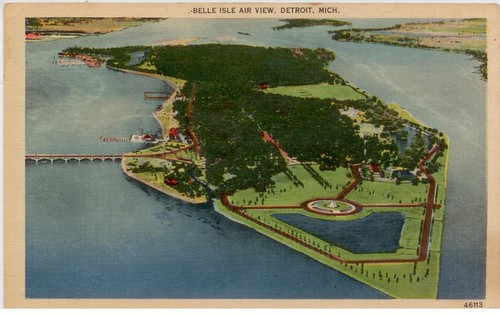European Garden Festivals as a model urban planning initiative for Detroit and other US cities
I already mentioned how IBA, the Inernational Building Exhibition initiative in Germany that results in major finished revitalization projects in selected German cities. The most recent program was in Hamburg.
The program in the Ruhr, in 1989, "Emscher Park," is a good model for Detroit as it focused on reclaiming vacant industrial buildings and sites by repurposing them as parks and recreation spaces ("EMSCHER PARK: FROM DERELICTION TO SCENIC LANDSCAPES").
I have been somewhat derisive of all the various urban agriculture programs proposed for Detroit ("Urban farming takes hold in blighted Motor City," MSNBC), if only because they are more of a placeholder initiative, using up land that will otherwise be vacant.
That being said, Toronto has a "GrowTO Urban Agriculture Action Plan" which outlines a systematic approach. Edible City is a book published as part of a series about Toronto issues focusing on the broad range of food issues affecting the city.
A Garden Festival Program for the US could start with Detroit. What I have been thinking is that Detroit would be a good place for the US to initiate a version of Europe's (Inter)National Garden Festivals. Germany, the Netherlands, and the UK have utilized such events, first created in Germany in 1951. From Grounds for Review: The Garden Festival in Urban Planning and Design:
Garden festivals uniquely precipitate and mark urban change with a celebratory, transformative and memorable event. ... they have been identified with major reclamation projects, novel planning strate[gies], major exhibitions of horticulture and public art, and the creation of new urban parks.Since 1951, there have been more than 50 such festivals in Europe. And to maximize the impact in Hamburg, the International Garden Festival was held simultaneously with IBA.
Plus, with sustainability as a major concern and initiative in cities across the world, expanding the purview of the garden festival into green infrastructure is a logical extension of the concept. (Although it's a fine line between green infrastructure and "suburbanizing" the city.)
-- Sustainable Cities Collective
Campus Martius Park, Detroit. PPS image.
However, I could see modifying such an event somewhat to include urban agriculture and market gardens, if only because such events are already happening. Although I wouldn't say creating new parks is necessarily a top priority, given that the city is bankrupt and is letting existing parks languish.
On the other hand there are a number of high priority initiatives underway:
- one initiative is creating a city bikeway trail system, not unlike the proposal for the Atlanta Beltline project, albeit not as ambitious
- the Campus Martius park project (Project for Public Spaces was a lead in creating it) created a fabulous urban park in Downtown Detroit
- the state took over Belle Isle Park, an island in the Detroit River, on a 30-year lease to be able to maintain the park in the face of Detroit's financial problems
- I don't understand why the Huron Clinton Metropolitan Park Authority isn't more involved in dealing with the Detroit Park situation (which I've written about in the context of the Detroit Institute of Arts and funding of cultural assets, see "Changing the structure of local government revenue generation")
- although a three county millage was instituted a few years ago to fund the Detroit Zoo ("Snyder - Calley signs bills to ensure funding for Detroit Zoo," Michigan State press release)
- "New retail, activated parks and plazas, and other highlights from 'A Placemaking Vision for Downtown Detroit'," Mlive.
 Traditional Flower and Garden Festivals. Note that the National Garden Festival in Buffalo ("GardenWalk Buffalo" and "Garden Tourism") is more an exhibition and less an urban planning and reclamation project, but still an interesting model.
Traditional Flower and Garden Festivals. Note that the National Garden Festival in Buffalo ("GardenWalk Buffalo" and "Garden Tourism") is more an exhibition and less an urban planning and reclamation project, but still an interesting model. Also see "Great Gardening: Ideas take root at garden tourism forum" and "Garden tourism benefits the economy and much more" from the Buffalo News.
The book Garden Tourism by Professor Richard Benfield of Central Connecticut State University, covers the tourism end of the field, focusing on house gardens, arboretums, flower festivals, etc.
Challenging the traditional garden show format. One way to up the revitalization quotient of more traditional garden events is to move towards the guerrilla end. The Chelsea Fringe Festival in London is an "alternative garden festival" that developed as a response by artists, designers, activists and others to put on events and actions that didn't fit into the more formal format of the Royal Horticultural Society's Chelsea Garden Show.
GROW London is a more upscale event that focuses on promoting city gardening, marketing itself as a "contemporary garden fair." (It reminds me that when I was a Main Street manager I suggested doing a spring street festival focused around gardening, yards, planting, and outdoor crafts.)
Plants as sculpture. One thing you don't see much of in public spaces is plants as public art, other than being key elements of landscape architecture and beauty in public spaces. Artist Jeff Koons has created some plant covered sculptures (Split-Rocker, Puppy) that end up being displayed in public places. See "A Jeff Koons sculpture is coming to 30 Rock" from the New York Times.
Smaller scale endeavors. We can't forget community gardening as a sub-set of community intervention, although it tends to function at a more micro scale, of blocks and neighborhoods, rather than at the citywide scale. Plenty of resources exist on the topic.
Seed bombing too. Where people plant in otherwise public, but ignored, spaces.
Corn grown in a front yard on New Hampshire Avenue NW in the Petworth neighborhood of Washington, DC.
More micro scaled actions include using front yards as vegetable gardens and edible landscapes, or as meadows.
Some DC residents grow either vegetables or flowers in treeboxes.
Labels: change-innovation-transformation, parks planning, sustainable land use and resource planning, urban design/placemaking, urban revitalization








2 Comments:
If I remember from Landry's book wasn't Emschler park part of a much bigger initiative to also bring in housing, environmental clean-up, and investment in smaller scale industry and job training? Not to deny it's importance but to position it within a larger framework of change and planning.
Yes, it was part of an IBA--International Building Exposition--and a major, multi year project.
The area also was the host of the European Capital of Culture in 2010... and it looks like I get to go there as part of a study tour in late August.
Post a Comment
<< Home